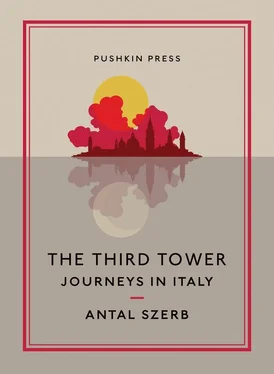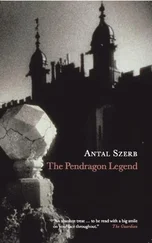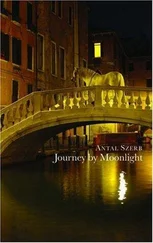If I were compelled to speak with total candour, I would say that it is for these back alleys that I love Italy. For me, they represent what gardens were to the age of Goethe, and what “Nature” was to the Romantics. No snow-covered peak, no glacier, mountain lake or stream, no sea or parkland could ever move me like the back alleys of an old Italian city. My dreams, my moods of nostalgia, lead me thither. The first time I set eyes on an Italian hilltop town with these same tiny streets I felt the deepest ecstasy I had ever known.
What this is in me I do not know. Under the influence of these little passageways I experience an altered state so deep I simply cannot regard it as the sort of emotion you would expect from a historically minded person; it is so much more intense and instinctive. I am aware of the usual Freudian explanation, and it bores me. It is so plausible I no longer believe it.
IN THE FIRST HOTEL that promised an available room, the waiter spoke French. I panicked. Instinct told me, as the event confirmed, that the French language would not come cheap there. Where they address you in German, it is because they know you have no money; where the language is French, they take you for a member of the aristocracy. I did not linger in that particular establishment. Eventually I came to anchor in a little pensione that nestled, in the most historical way imaginable (embedded, as it were, in world history), in a building right beside the Clock Tower, the Torre dell’Orologio, in St Mark’s Square, by the entrance to the Merceria. From my window I can study some of the more intimate details of the Basilica. Directly above my head the two bronze men bong out the hours. I feel as a mouse would in a slipper of the great Doge Morosini.
The food here is tolerable. The tiny window of the dining room opens onto St Mark’s Square. The guests speak various dialects of French and German. A French family: two mothers (or, rather, one of them must be a mother, though I can’t work out which) and two daughters. You would think that gaucherie was the preserve of the Northern races, but from my observation of these two French ladies and other French guests they offer strong competition to the Germans. It’s just that theirs is a different sort of gaucherie: more gracious. Or is this just my prejudice?
THE ITALIANS adore Hungary. Every day you read in the papers: “Family house on Lake Balaton”, or “Nostalgie di Halászbástya”. (For them, as I see it, “nostalgia” signifies “ambience” or “atmosphere”—what a wise language!) And people respond most warmly when they hear the word “Ungheria”. I get the impression that the name implies almost as much for Italians as “Italy” does for us — a friendly, romantic and fundamentally different country. What attracts us to them is that everything there is so old, and what attracts them to us is that everything we have is so new — a closely related thing. I once watched a group of Italian tourists gazing in reverence at the Pasaréti Church: they had never before seen such a new one.
I was once asked in England how I could possibly have left my own highly romantic country for such a grey, petty-bourgeois place. Naturally my questioners were Italian.
THE VAST, classical Square and the Byzantine Basilica of St Mark form an organic whole, but logically speaking they are mutually contradictory. The Procuratorial buildings and the Piazza represent the culmination of European culture: the Basilica is primordial, barbarically gilded, primitive, pre-European, older than anything European. When it was built, Europe had not yet fully decided to become what it now is. It might have been another Byzantium.
Over its portal one sees an iron grill of which any village blacksmith today would be ashamed. What a rudimentary lion stands atop St Mark’s column on the quay… and the Don Quixote on the column opposite! The two porphyry lions behind the Basilica are so childishly clumsy you feel compelled to stroke their manes. I see these same red lions again and again in Northern Europe, crouching tamely in front of churches, as if begging for alms.

But what does mere technique matter? Here, the spirit is everything. St Mark’s Square is no larger than Szeged’s Dóm Tér, but what miraculous grandezza , in its immediate setting and the wider Venetian context! Its very grandeur stems from this contradiction: that, small as the place was, they never stinted on the offerings they made to their own greatness. And the secret of the Basilica is that when Venice was still no more than a clearing in the jungle, in the European middle ages, they could sacrifice so much gold, and physical labour, and beauty, to their God and patron saint. If St Mark’s were built today, would it genuinely please as much, for example, as the Duomo in Florence? I doubt it. The Campanile is a modern construction, and one senses a certain sacrilege about it. The Basilica of St Mark is modern in no sense at all.
But… why do they always play the Blue Danube and Die Fledermaus ?
THIS IS WHERE the doges rest, after their labours ruling the city. In front of it, the equestrian statue of Bartolomeo Colleoni — the quintessential equestrian statue and reference point for every subsequent such tribute to kings and generals. None of them surpasses the grim, manly features of the condottiere , or the perfect unity of horse and rider so justly admired by art historians. But inside the Basilica I saw a tomb on which the dead man was no less inseparable from his coffin than the condottiere from his horse. I found that much more affecting. Not everyone comes into the world associated with a horse. But with a coffin…
The impermanence of things. Venice found itself on the road to annihilation once before, at the start of the nineteenth century, an appalling decline that was eventually arrested. But for how much longer? Here in the Zanipolo, standing above the tombs of the doges, I am filled once again by that overpowering vision that haunts all of us who concern ourselves with the inner workings of history and Schiller’s “prophecy of hindsight”. The time will come when the human race, horribly reduced in numbers, will scrabble for a living in the mansions of the world’s great cities like troglodytes in caves. We can see this process already beginning in some of the oldest metropolitan centres: at the Place des Vosges in Paris, in the Orsini Palace in Rome, and here in Venice in the more outlying palazzi along the Grand Canal. First will come a time when the Ducal Palace is divided into tiny bedroom-and-kitchen flats; then a time when even they are no longer needed. This is how antiquity itself passed away: there were centuries during which Rome had no more inhabitants than a village. The Eskimo scene in Madách’s The Tragedy of Man is set in the world of the natural sciences. If Madách were writing today he would surely have placed this episode not in the polar regions but in St Mark’s Square, or the Place de l’Opéra in Paris, and Eve would emerge not from an igloo, but from the ruins of a stairway leading down to the Métro.
I CANNOT DECIDE which was here first, the water or the houses. I think it must have been the water; but how is it that the water should begin so precisely where the houses end? One has the impression that they must have built the streets first and then put the water in position.
Читать дальше













